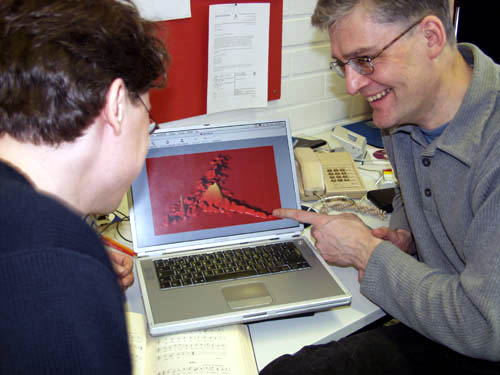Mining the music
– by whistling or singing karaoke
Tiedonjyvä 5/2003
Tarja Vänskä-Kauhanen

Visualization of the rhythmic structure of folk songs, suggesting three distinct rhythmic types within collection. Tuomas Eerola and Petri Toiviainen of the Deparment of Music have developed the musical mining database of the Finnish folk songs archive.
Petri Toiviainen and Tuomas Eerola highly respect the work of Ilmari Krohn (1863-1960) who published melodies and lyrics of Finnish folk tunes collecting over 9000 pieces from right across the country.
- Except those which he considered too immoral to be printed, they add.
Copies of Suomen Kansan Sävelmiä - which freely translates as 'Finnish Folk Tunes', published from 1898-1933, are still treasured within Finnish folk music circles.
eTunes to network material
These two reseachers are now about to publish the outcomes of a project on digitalization of tunes. Essentially this involves preparing the database as network learning material which could be used on the Internet.
Sitting by your computer you can search for the tune you have sometimes heard and the database will reveal both the origin of the notation and also the verses and variations. It also plays the melody aloud.
- It is soon quite possible that you will be able to whistle or hum the tune, and as a result of the search, get all the information the database provides, Tuomas Eerola explains.
One wonders what this could do for karaoke fans!
Geographical innovation
- Musical data mining is not a new invention, but as a nation-wide resource of this type it breaks new ground by providing researchers with new ways to analyse musical data. Archives as in Essen, Germany, or Hungarian collections comprising some 2 300 tunes are so far the major examples of folk music databases.
When Ilmari Krohn and his colleagues transcribed the melodies they noted each localtion of origin. It was Toiviainen and Eerola´s idea to combine specific information with a geographical coordinate database. Now geographical comparisons can be made it is possible to follow the geographical variation of musical features. For instance, schools can now identify and trace folk tunes originating from their own regions.
- New opportunities for use will certainly appear. But as of now this is a new feature of Finnish folk music research, Toiviainen says.
Tool for cognitive music analysis
Toiviainen and Eerola have also jointly created a method for comparative analysis of folk music based on musical feature extraction and neural networks. And for any researcher specialized in cognitive modelling, especially with neural nets as well as other nonlinear systems or computer-aided music analysis, the database is also a tool which can be used in a variety of ways.
In terms of global music research, issues such as classification and identification are of considerable importance.
Remarkable cultural innovation
The Finnish Literary Society has declared that the eSävelmat-eTunes database is a remarkable cultural innovation. Once outstanding copyright issues are clarified on certain tunes, the database will swing into full action.

The Finnish Literary Society has declared that the eSävelmat–eTunes database is a remarkable cultural innovation.
Start of the page
10.6.2003 pageadmin@jyu.fi
|